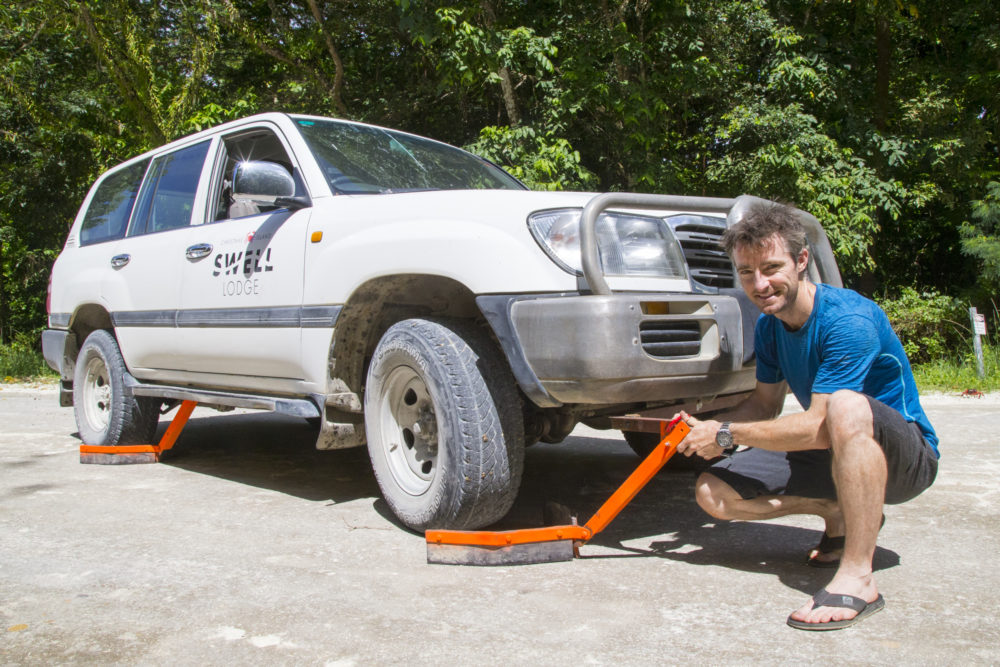Keeping red crabs safe
A young couple’s unique invention to save Christmas Island’s famous red crabs from being crushed by vehicles is gaining international attention, with countries a far afield as Colombia also now keen to reduce their crustacean road-toll.
Every Christmas, thousands of Christmas Island red crabs are accidentally crushed on the roads of this wildlife-filled Australian Island as 50 million of them embark on their annual migration – a spectacle described by Sir David Attenborough as one of the “10 greatest natural wonders on Earth”.
Red crab season
During November to January, many of the island’s roads are closed, their current status listed like ski-field runs on permanent roadside displays. Major routes remain open however and around town, some locals use garden rakes try and clear paths for passing vehicles, but still, many are killed.
Wildlife photographers Chris and Jess Bray moved to the remote, tropical paradise of Christmas Island in September to create ‘Swell Lodge’ – a luxury eco-lodge approved inside the national park – but when the crabs recently brought construction access to a halt, Mr. Bray turned his attention to creating something that many locals have been dreaming of for decades: a crab-safe vehicle attachment.
A unique solution
Aware of this impending crab problem, earlier this year Mr. Bray engaged a class of engineering students at the University of NSW to help devise a solution. “The students had some great ideas, including air-blowers and spring-loaded arrays of hinged brooms,” said Mr. Bray, “But when the crabs appeared, I had to make-do with what I could find on-island – just some scrap metal and bits of worn-out conveyor belt rubber from the local phosphate mine.”
Little more than clamped-on trailing arms which drag a rubber crab-deflector in front of each of the four wheels, it’s a simple enough design, yet one that’s proved surprisingly effective, thus the crab safe vehicle attachment was born. “It would’ve been easy if all the roads were flat,” Bray laughs, “but to provide access to our eco-lodge during migration without killing any crabs, it needed to work on 4WD tracks too.” After demonstrating it on roads around town, the attachments were assessed by Robert Muller, Chief Ranger of the Christmas Island National Park, who followed their vehicle on foot for over a kilometer along a crab-covered 4WD trail, without a single crab mortality. The crab safe vehicle attachment was declared a success!
“We think it’s fantastic!” Says Mr. Muller from Christmas Island National Park, “I can’t believe someone hasn’t thought of this before. I think we’ll need to order a few ourselves!”
A short video on the invention is being shared widely on social media (https://www.youtube.com/watch?v=Yx-RCB3hSig), tourists have started asking where they can hire them and groups from Colombia are seeking advice from Parks about crab counter-measures.
Sustainable tourism
With Christmas Island’s detention centre closing down and the phosphate mine drying up, the island’s economy is shifting towards a more sustainable focus. Tourism numbers are on the rise, with the majority of visitors coming to experience the island’s spectacular natural beauty. Known as ‘The Galapagos of the Indian Ocean’, the island features diverse and unusual landscapes, endemic birds and world-class snorkelling and diving in crystal-clear, 28-degree water with coral reefs and drop-off walls, turtles, resident dolphins and in the right season, manta rays and even whale sharks.
“Walking the last 2km into Swell Lodge through a jungle carpeted with red crabs will be an incredible experience many guests may choose,” predicts Mr. Bray, “but some will prefer to drive, and right now, carting in all our building supplies using a wheelbarrow is exhausting, so we’re pretty stoked to be able to drive again, albeit slowly!”
For more information:
Best time to visit Christmas Island
Luxury accommodation on Christmas Island
Swell Lodge accommodation prices
Christmas Island Experiences

